Natural Fractures and Their Contribution to Natural Gas Migration and Accumulation in Marine Carbonate Reservoirs: Lower Triassic Feixianguan Formation, Northeast Sichuan Basin, China
Abstract
:1. Introduction
2. Geological Setting
3. Data and Methods
4. Results
4.1. Types of Natural Fractures
4.2. Characteristics of Natural Fractures
4.3. Timing of Tectonic Fractures
5. Discussion
5.1. Effectiveness of Natural Fractures
5.2. Influence on Gas Migration and Accumulation
5.3. Contribution of Natural Fractures to Productivity
6. Conclusions
Author Contributions
Funding
Institutional Review Board Statement
Informed Consent Statement
Data Availability Statement
Acknowledgments
Conflicts of Interest
References
- Garland, J.; Neilson, J.; Laubach, S.E.; Whidden, K.J. Advances in carbonate exploration and reservoir analysis. Geol. Soc. Spec. Publ. 2012, 370, 1–15. [Google Scholar] [CrossRef]
- Lucia, F.J.; Kerans, C.; Jennings, J.J.W. Carbonate reservoir characterization. J. Pet. Technol. 2003, 55, 70–72. [Google Scholar] [CrossRef]
- Moore, C.H.; Wade, W.J. Carbonate Reservoirs: Porosity and Diagenesis in a Sequence Stratigraphic Framework; Elsevier: Amsterdam, The Netherlands, 2013; p. 67. [Google Scholar]
- Roehl, P.O.; Choquette, P.W. Perspectives on world-class carbonate petroleum reservoirs. Am. Assoc. Pet. Geol. Bull. 1985, 69, 148. [Google Scholar]
- Lavenu, A.P.C.; Lamarche, J.; Gallois, A.; Gauthier, B.D.M. Tectonic versus diagenetic origin of fractures in a naturally fractured carbonate reservoir analog (Nerthe anticline, southeastern France). Am. Assoc. Pet. Geol. Bull. 2013, 97, 2207–2232. [Google Scholar] [CrossRef]
- Lorenz, J.C.; Farrell, H.E.; Hanks, C.L.; Rizer, W.D.; Sonnenfeld, M.D. Carbonate seismology: Characteristics of natural fractures in carbonate strata. Soc. Explor. Geophys. Geophys. Dev. Ser. 1997, 6, 197–202. [Google Scholar]
- Wennberg, O.P.; Casini, G.; Jonoud, S.; Peacock, D. The characteristics of open fractures in carbonate reservoirs and their impact on fluid flow, a discussion. Pet. Geosci. 2016, 22, 91–104. [Google Scholar] [CrossRef]
- Finkbeiner, T.; Barton, C.A.; Zoback, M.D. Relationships among in-situ stress, fractures and faults, and fluid flow, Monterey Formation, Santa Maria Basin, California. Am. Assoc. Pet. Geol. Bull. 1997, 81, 1975–1999. [Google Scholar]
- Zeng, L.B.; Tang, X.M.; Wang, T.C.; Gong, L. The influence of fracture cements in tight Paleogene saline lacustrine carbonate reservoirs, western Qaidam Basin, northwest China. Am. Assoc. Pet. Geol. Bull. 2012, 96, 2003–2017. [Google Scholar] [CrossRef]
- Hollis, C.; Vahrenkamp, V.; Tull, S.; Mookerjee, A.; Taberner, C.; Huang, Y.D. Pore system characterisation in heterogeneous carbonates, An alternative approach to widely-used rock-typing methodologies. Mar. Pet. Geol. 2010, 27, 772–793. [Google Scholar] [CrossRef]
- Laubach, S.E.; Eichhubl, P.; Hilgers, C.; Lander, R. Structural diagenesis. J. Struct. Geol. 2010, 32, 1866–1872. [Google Scholar] [CrossRef]
- Antonellini, M.; Mollema, P.N. A natural analog for a fractured and faulted reservoir in dolomite; Triassic Sella Group, northern Italy. Am. Assoc. Pet. Geol. Bull. 2000, 84, 314–344. [Google Scholar]
- Sagi, D.A.; De Paola, N.; McCaffrey, K.J.W.; Holdsworth, R.E. Fault and fracture patterns in low porosity chalk and their potential influence on sub-surface fluid flow—A case study from Flamborough Head, UK. Tectonophysics 2016, 690, 35–51. [Google Scholar] [CrossRef]
- Barton, C.; Moos, D.; Tezuka, K. Geomechanical wellbore imaging, Implications for reservoir fracture permeability. Am. Assoc. Pet. Geol. Bull. 2009, 93, 1551–1569. [Google Scholar] [CrossRef]
- Hennings, P.; Allwardt, P.; Paul, P.; Zahm, C.; Reid, R.; Alley, H.; Kirschner, R.; Lee, B.; Hough, E. Relationship between fractures, fault zones, stress, and reservoir productivity in the Suban gas field, Sumatra, IndonesiaSuban Gas Field, Sumatra, Indonesia. Am. Assoc. Pet. Geol. Bull. 2012, 96, 753–772. [Google Scholar]
- Wang, Z.; Lü, X.X.; Wang, S.; Li, Y.; Zhou, X.X.; Quan, H.; Li, R.B. Fracture systems and petrophysical properties of tight sandstone undergoing regional folding, A case study of the Cretaceous reservoirs in the Kuqa foreland thrust belt, Tarim Basin. Mar. Pet. Geol. 2020, 112, 104055. [Google Scholar] [CrossRef]
- Gudmundsson, A.; Simmenes, T.H.; Larsen, B.; Philipp, S.L. Effects of internal structure and local stresses on fracture propagation, deflection, and arrest in fault zones. J. Struct. Geol. 2010, 32, 1643–1655. [Google Scholar] [CrossRef]
- Jeanne, P.; Guglielmi, Y.; Lamarche, J.; Cappa, F.; Marié, L. Architectural characteristics and petrophysical properties evolution of a strike-slip fault zone in a fractured porous carbonate reservoir. J. Struct. Geol. 2012, 44, 93–109. [Google Scholar] [CrossRef]
- Yao, Y.T.; Zeng, L.B.; Mao, Z.; Han, J.; Cao, D.S.; Lin, B. Differential deformation of a strike-slip fault in the Paleozoic carbonate reservoirs of the Tarim Basin, China. J. Struct. Geol. 2023, 173, 104908. [Google Scholar] [CrossRef]
- Fan, X.J.; Peng, J.; Li, J.X.; Chen, D.; Li, F.; Deng, J.H.; Miao, Z.W. Fracture characteristics of ultra-deep reef-bank lithologic gas reservoirs in the Upper Permian Changxing Formation in Yuanba area, northeastern Sichuan Basin. Oil Gas Geol. 2014, 35, 511–516, (In Chinese with English Abstract). [Google Scholar]
- Jiang, L.; Worden, R.H.; Cai, C.F.; Shen, A.J.; He, X.Y.; Pan, L.Y. Contrasting diagenetic evolution patterns of platform margin limestones and dolostones in the Lower Triassic Feixianguan Formation, Sichuan Basin, China. Mar. Pet. Geol. 2018, 92, 332–351. [Google Scholar] [CrossRef]
- Guo, X.S.; Hu, D.F.; Li, Y.P.; Duan, J.B.; Ji, C.H.; Duan, H. Discovery and theoretical and technical innovations of Yuanba gas field in Sichuan Basin, SW China. Pet. Explor. 2018, 45, 15–28. [Google Scholar] [CrossRef]
- Ma, X.H.; Yang, Y.; Wen, L.; Luo, B. Distribution and exploration direction of medium- and large-sized marine carbonate gas fields in Sichuan Basin, SW China. Pet. Explor. 2019, 46, 1–15. [Google Scholar] [CrossRef]
- Jiang, L.; Worden, R.H.; Cai, C.F.; Li, K.K.; Xiang, L.; Cai, L.L.; He, X.Y. Dolomitization of gas reservoirs, the upper Permian Changxing and lower Triassic Feixianguan Formations, Northeast Sichuan Basin, China. J. Sediment. Res. 2014, 84, 792–815. [Google Scholar] [CrossRef]
- Huo, F.; Wang, X.Z.; Wen, H.G.; Xu, W.L.; Huang, H.W.; Jiang, H.C.; Li, Y.W.; Li, B. Genetic mechanism and pore evolution in high quality dolomite reservoirs of the Changxing-Feixianguan Formation in the northeastern Sichuan Basin, China. J. Pet. Sci. Eng. 2020, 194, 107511. [Google Scholar] [CrossRef]
- Ma, Y.S.; Guo, X.S.; Guo, T.L.; Huang, R.; Cai, X.Y.; Li, G.X. The Puguang gas field, New giant discovery in the mature Sichuan Basin, southwest China. Am. Assoc. Pet. Geol. Bull. 2007, 91, 627–643. [Google Scholar] [CrossRef]
- Ma, Y.S.; Cai, X.X.; Li, G.X. Basic characteristics and concentration of the Puguang Gas Field in the Sichuan Basin. Acta Geol. Sin. 2005, 79, 858–865, (In Chinese with English Abstract). [Google Scholar]
- Ding, X.; Wu, H.; Sun, Y.F.; Yu, H.H.; Zhao, Z.H.; Chen, J.S.; Tang, Q.S. Genetic types of carbonate shoal reservoirs in the Middle Triassic of the Sichuan Basin (SW China). Mar. Pet. Geol. 2019, 99, 61–74. [Google Scholar] [CrossRef]
- Tan, X.C.; Liu, H.; Li, L.; Luo, B.; Liu, X.G.; Mou, X.H.; Nie, Y.; Xi, W.Y. Primary intergranular pores in oolitic shoal reservoir of lower triassic feixianguan formation, Sichuan Basin, Southwest China, Fundamental for reservoir formation and retention diagenesis. J. Earth Sci. 2011, 22, 101–114. [Google Scholar] [CrossRef]
- Shao, X.Z.; Qin, Q.R.; Fan, X.L.; Shi, L.C. Fracture prediction of the bottom of T1f4 in Huanglongchang structure, northeastern Sichuan Basin. Lithol. Reserv. 2011, 23, 96–100, (In Chinese with English Abstract). [Google Scholar]
- Wang, Y.F.; Zhao, X.Y.; Liu, C.C. Development characteristics and main controlling factors of natural fractures in reef-flat facies reservoirs of Changxing Formation in Yuanba area, northeastern Sichuan Basin. Nat. Gas Geosci. 2019, 30, 973–981, (In Chinese with English Abstract). [Google Scholar]
- Yao, Y.T.; Zeng, L.B.; Zhang, H.; Zhang, J.W.; Guan, C.; Liang, D. Fracture Development Laws of Feixianguan Formation Carbonate Reservoirs in Huanglongchang-Qilibei Area, Northeast Sichuan. Earth Sci. 2023, 48, 2643–2651. [Google Scholar]
- Tang, H.; Wang, Q.L.; Peng, X.L.; Li, L.; Huang, D.M. The Study of Fracture Characteristics and Causes at Feixianguan Formation inXuanhan Area of Eastern Sichuan. J. Southwest Pet. Univ. (Sci. Technol. Ed.) 2011, 33, 78, (In Chinese with English Abstract). [Google Scholar]
- Zhao, W.Z.; Luo, P.; Chen, G.S.; Cao, H.; Zhang, B.M. Origin and reservoir rock characteristics of dolostones in the Early Triassic Feixianguan Formation, NE Sichuan Basin, China, Significance for future gas exploration. J. Pet. Geol. 2005, 28, 83–100. [Google Scholar] [CrossRef]
- Li, P.P.; Zou, H.Y.; Yu, X.Y.; Hao, F.; Wang, G.W. Source of dolomitizing fluids and dolomitization model of the upper Permian Changxing and Lower Triassic Feixianguan formations, NE Sichuan Basin, China. Mar. Pet. Geol. 2021, 125, 104834. [Google Scholar] [CrossRef]
- Li, K.K.; George, S.C.; Cai, C.F.; Zhang, X.F.; Tan, X.F. Comparison of differential diagenesis of two oolites on the Lower Triassic platform margin, NE Sichuan Basin, Implications for the co-evolution of rock structure and porosity. Mar. Pet. Geol. 2020, 119, 104485. [Google Scholar] [CrossRef]
- He, D.F.; Li, D.S.; Zhang, G.W.; Zhao, L.Z.; Fan, C.; Lu, R.Q.; Wen, Z. Formation and evolution of multi-cycle superposed Sichuan Basin, China. Chin. J. Geol. 2011, 46, 589–606, (In Chinese with English Abstract). [Google Scholar]
- Laubach, S.E.; Olson, J.E.; Gross, M.R. Mechanical and fracture stratigraphy. Am. Assoc. Pet. Geol. Bull. 2009, 93, 1413–1426. [Google Scholar] [CrossRef]
- Ortega, O.J.; Marrett, R.A.; Laubach, S.E. A scale-independent approach to fracture intensity and average spacing measurement. Am. Assoc. Pet. Geol. Bull. 2006, 90, 193–208. [Google Scholar] [CrossRef]
- Dickson, J. A Modified Staining Technique for Carbonates in Thin Section. Nature 1965, 205, 587. [Google Scholar] [CrossRef]
- Zhao, G.; Jin, Z.J.; Ding, W.L.; Liu, G.X.; Yun, J.B.; Wang, R.Y.; Wang, G.P. Developmental characteristics and formational stages of natural fractures in the Wufeng—Longmaxi Formation in the Sangzhi Block, Hunan Province, China: Insights from fracture cements and fluid inclusions studies. J. Petrol. Sci. Eng. 2022, 208, 109407. [Google Scholar] [CrossRef]
- Goldstein, R.H.; Reynolds, T.J. Systematics of Fluid Inclusions in Diagenetic Minerals; SEPM Society for Sedimentary Geology: Tulsa, OK, USA, 1994. [Google Scholar]
- Ravier, E.; Guiraud, M.; Guillien, A.; Vennin, E.; Buoncristiani, J.F.; Portier, E. Micro-to macro-scale internal structures, diagenesis and petrophysical evolution of injectite networks in the Vocontian Basin (France), Implications for fluid flow. Mar. Pet. Geol. 2015, 64, 125–151. [Google Scholar] [CrossRef]
- Hantschel, T.; Kauerauf, A.I.; Wygrala, B. Finite element analysis and ray tracing modeling of petroleum migration. Mar. Pet. Geol. 2000, 17, 815–820. [Google Scholar] [CrossRef]
- Wang, Y.; Song, Y.; Shan, J.Z. Action of tectonic stress on hydrocarbon migration and accumulation. Oil Gas Geol. 2005, 26, 563–571, (In Chinese with English Abstract). [Google Scholar]
- Zeng, L.B.; Gong, L.; Guan, C.; Zhang, B.J.; Wang, Q.Q.; Zeng, Q.; Lyu, W.Y. Natural fractures and their contribution to tight gas conglomerate reservoirs, A case study in the northwestern Sichuan Basin, China. J. Petrol. Sci. Eng. 2022, 210, 110028. [Google Scholar] [CrossRef]
- Wang, Y.Y.; Chen, J.F.; Pang, X.Q.; Liu, Y.F.; Chen, Z.Y.; Luo, G.P.; Zhang, G.Q.; Huang, L.M. Faulting controls on oil and gas composition in the Yingmai 2 Oilfield, Tarim Basin, NW China. Org. Geochem. 2018, 123, 48–66. [Google Scholar] [CrossRef]

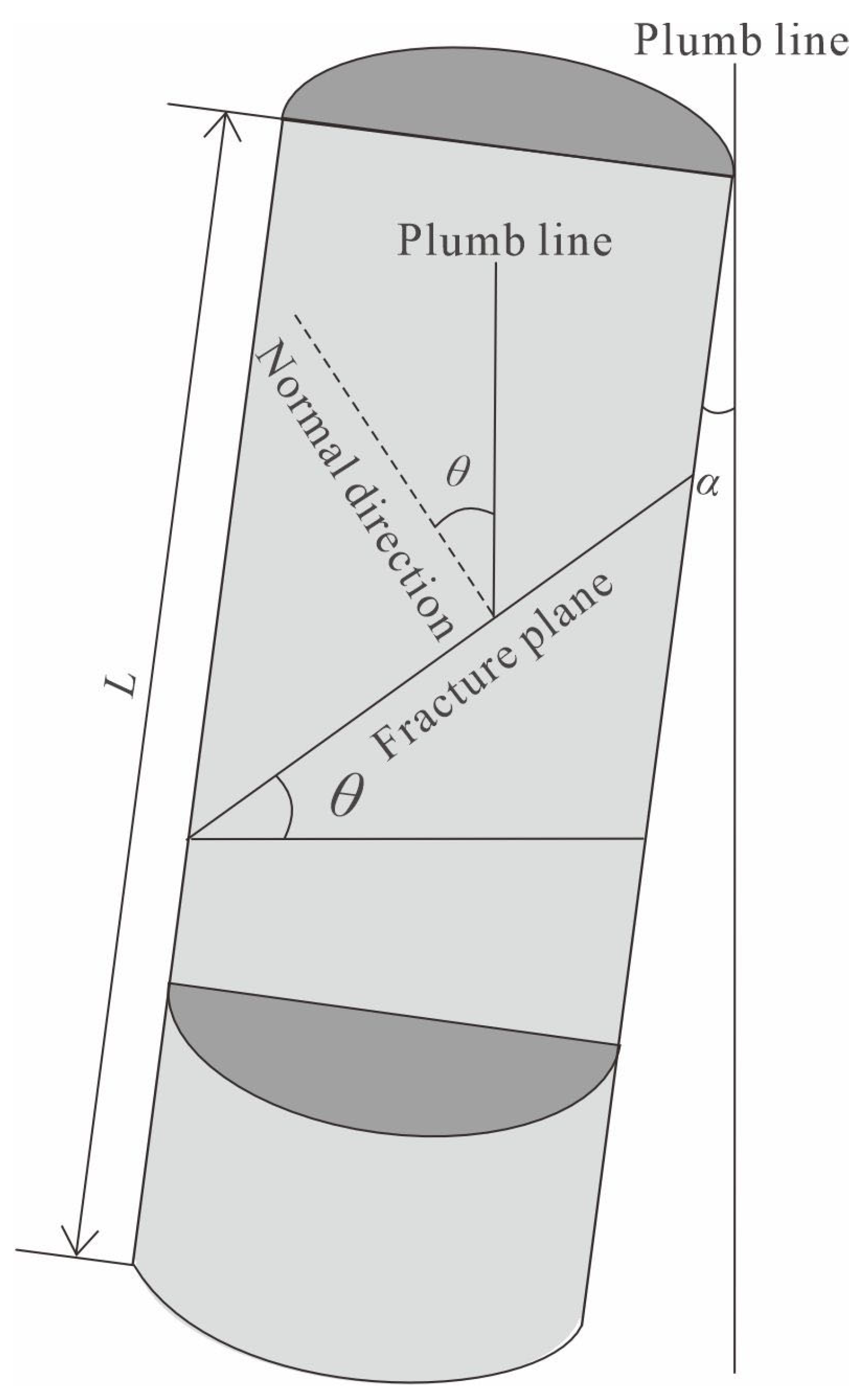

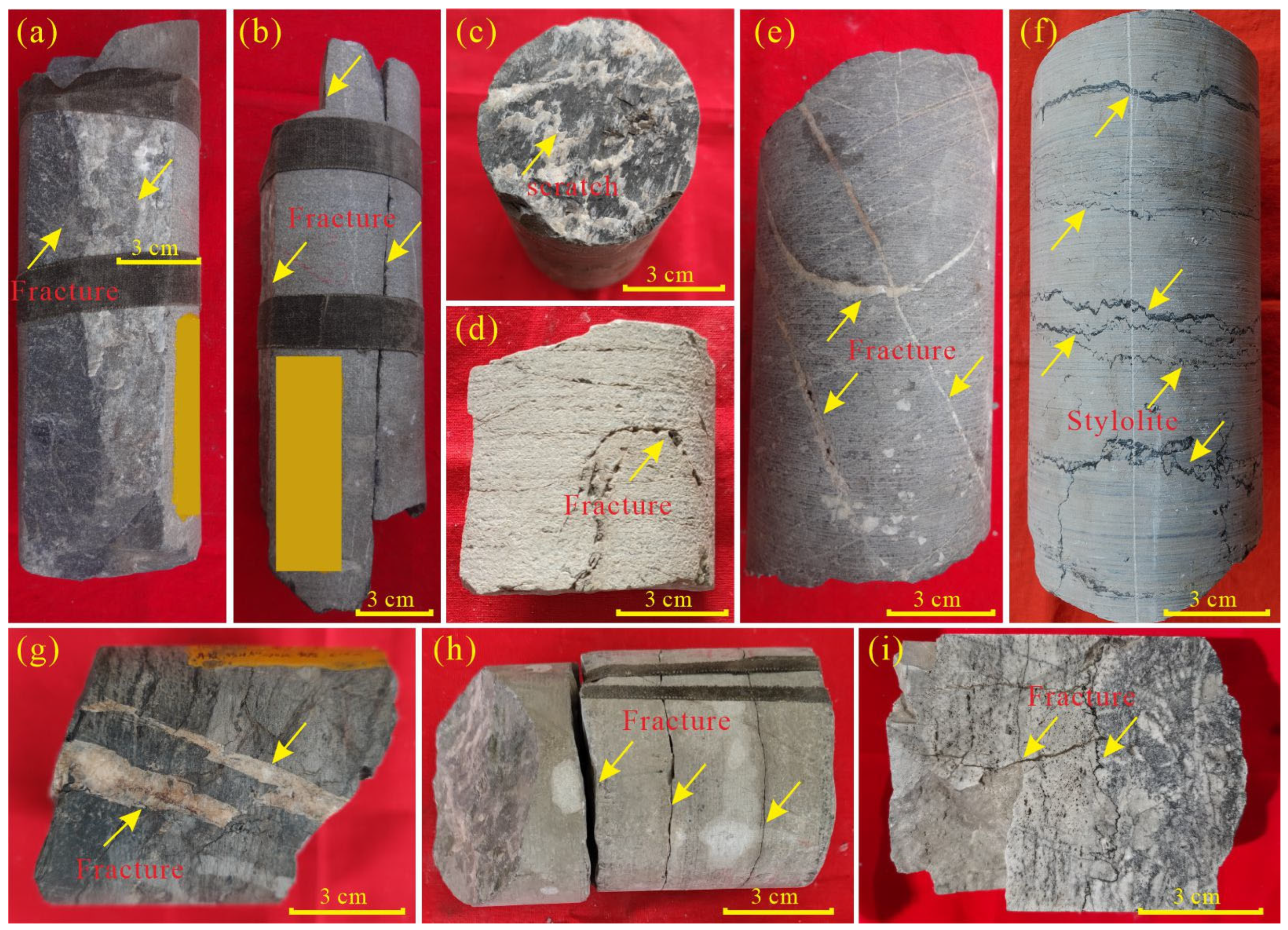
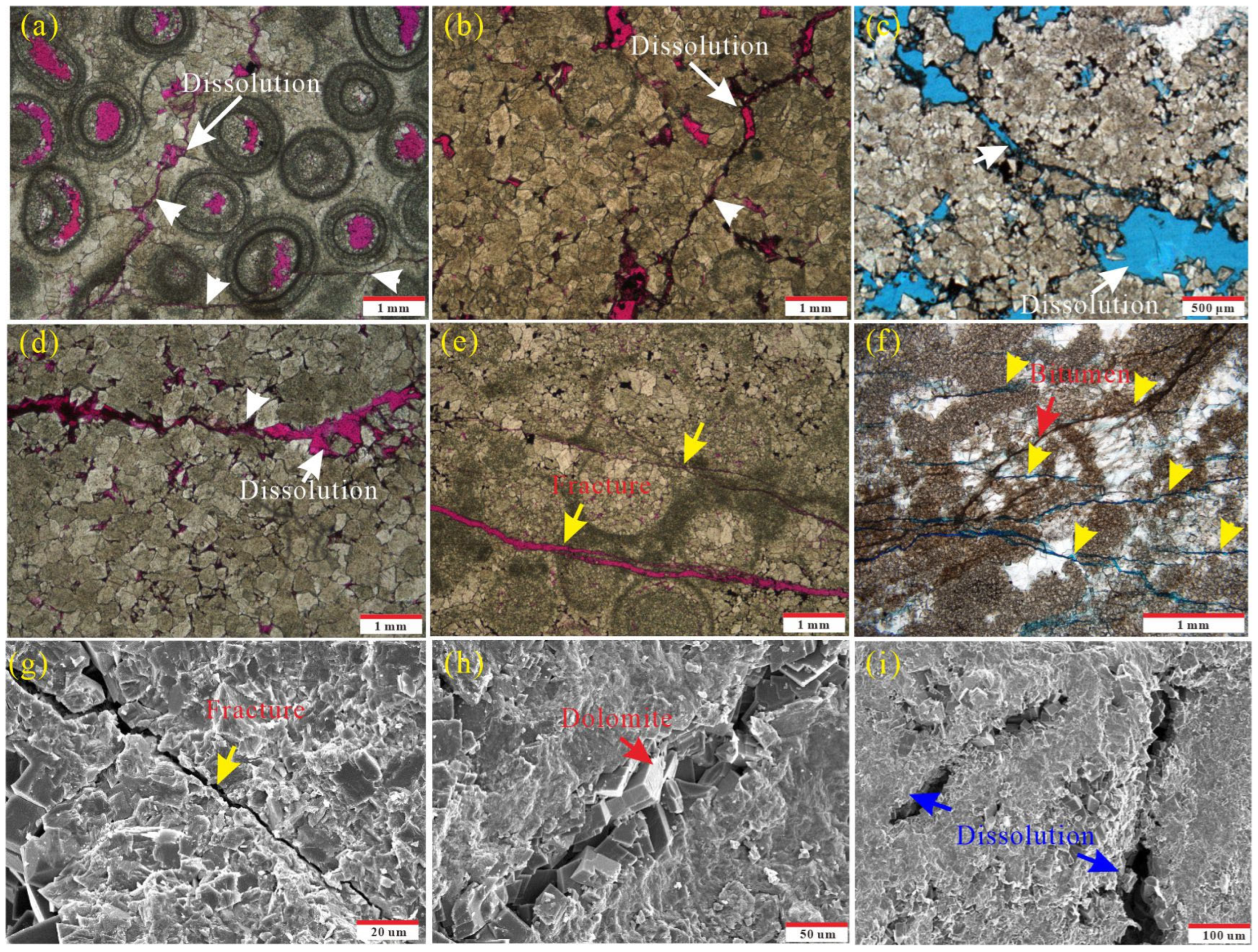
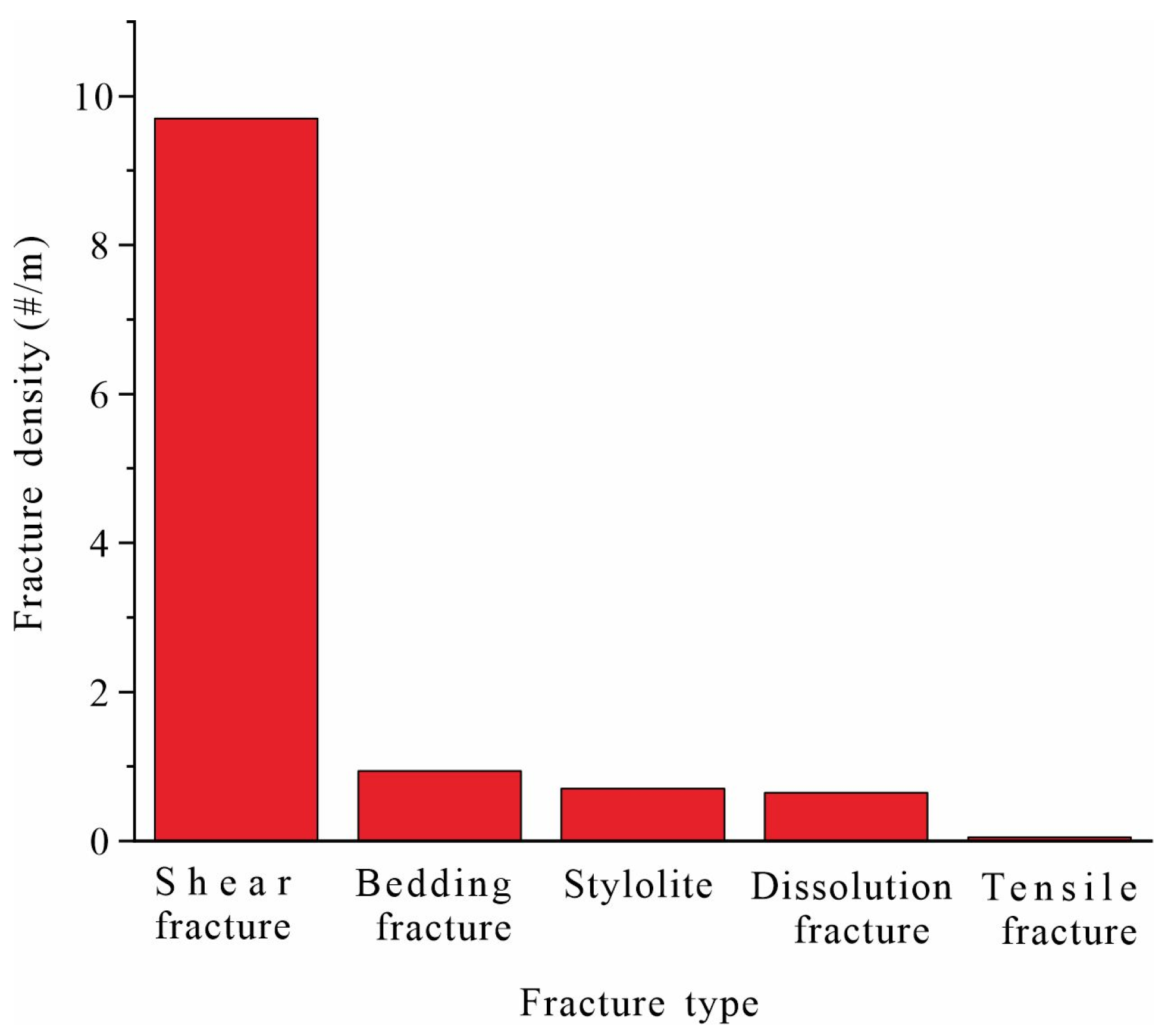
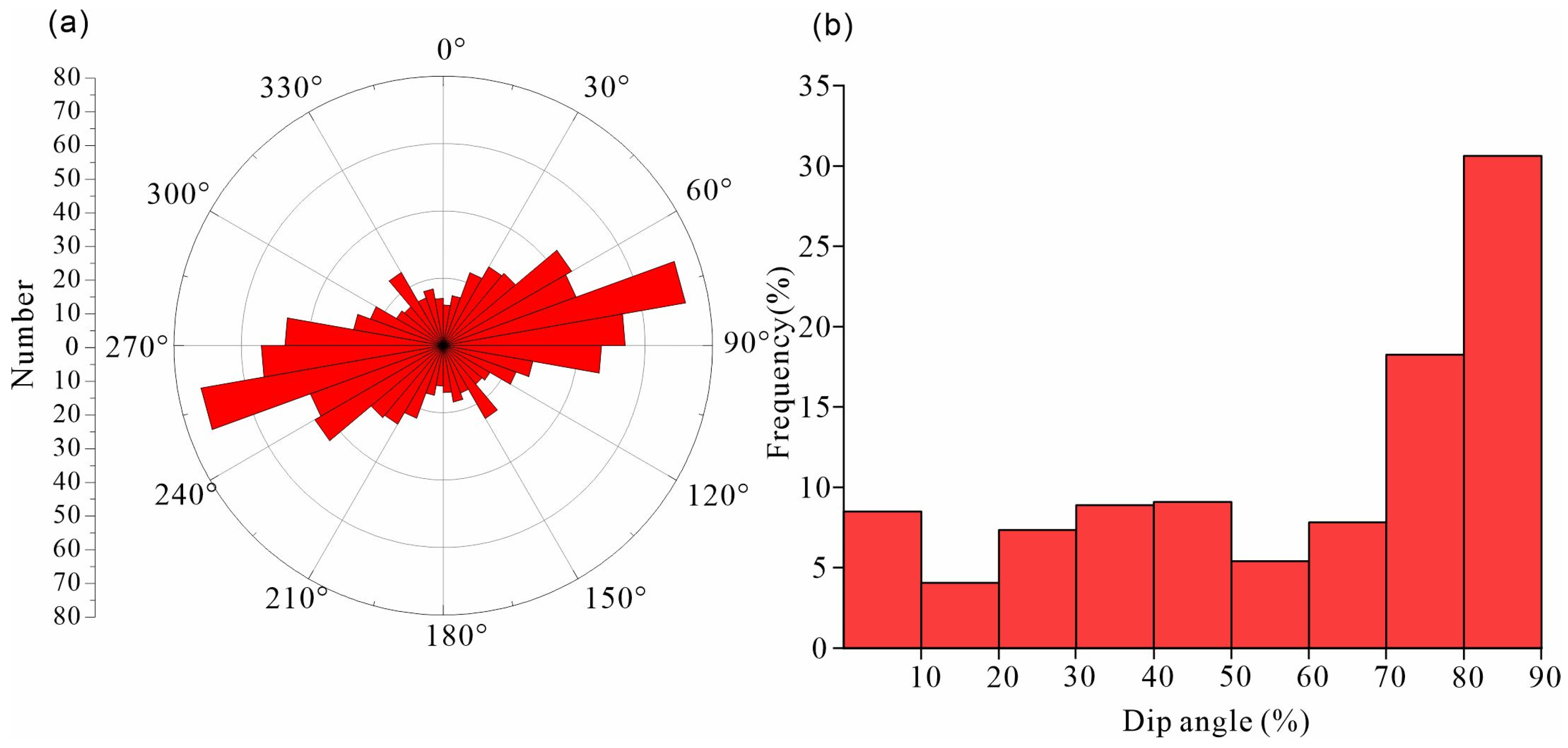

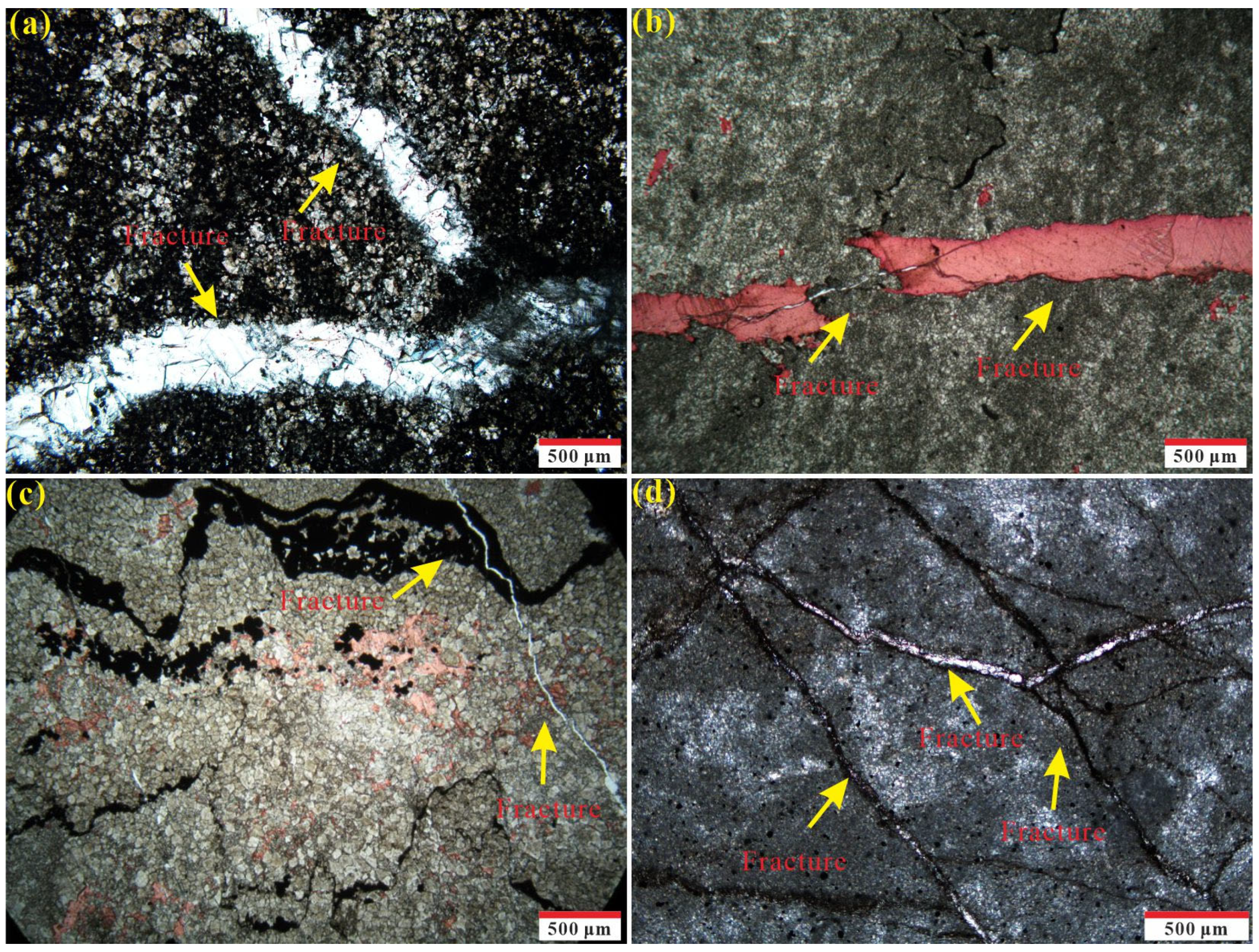
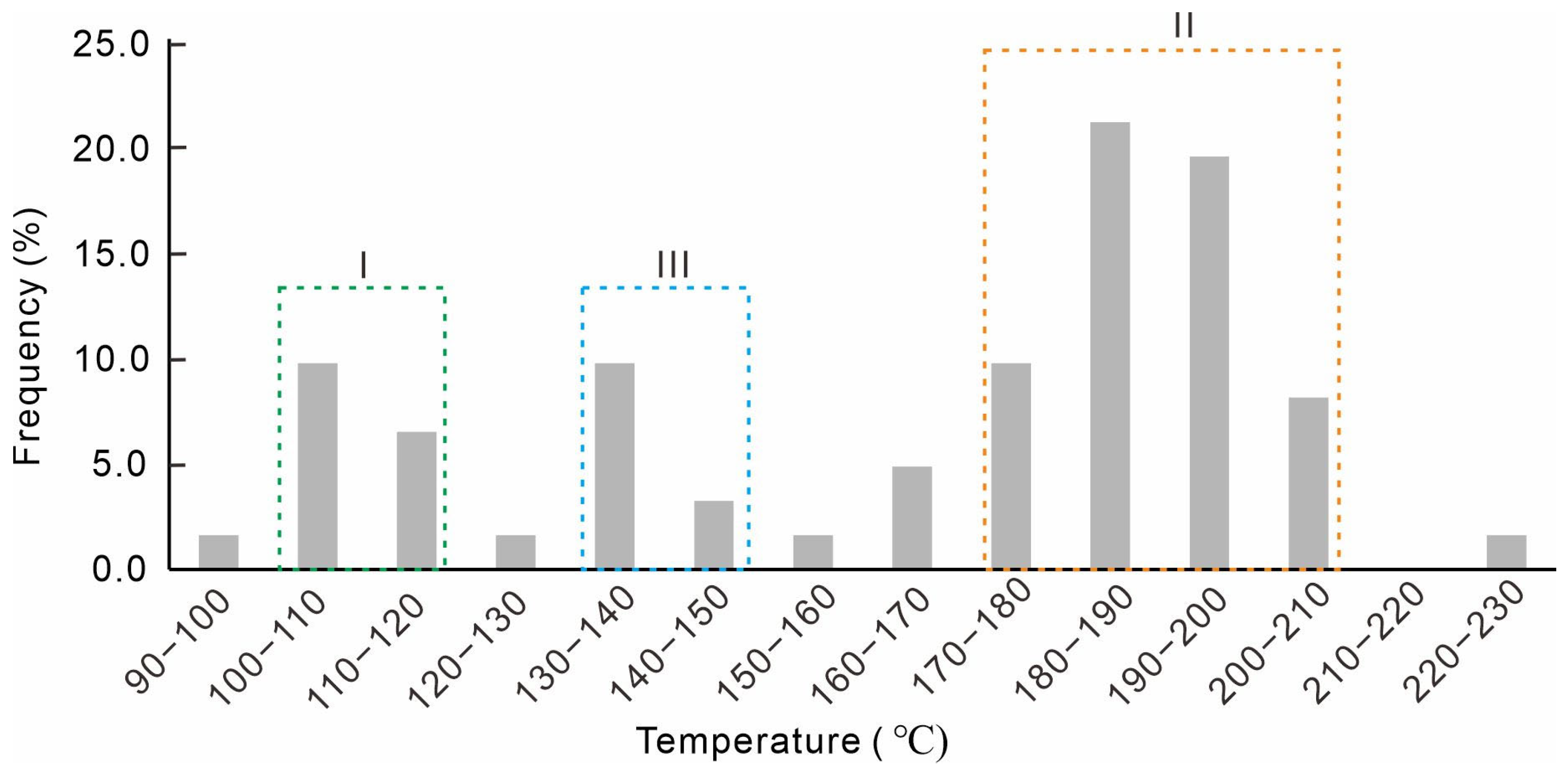


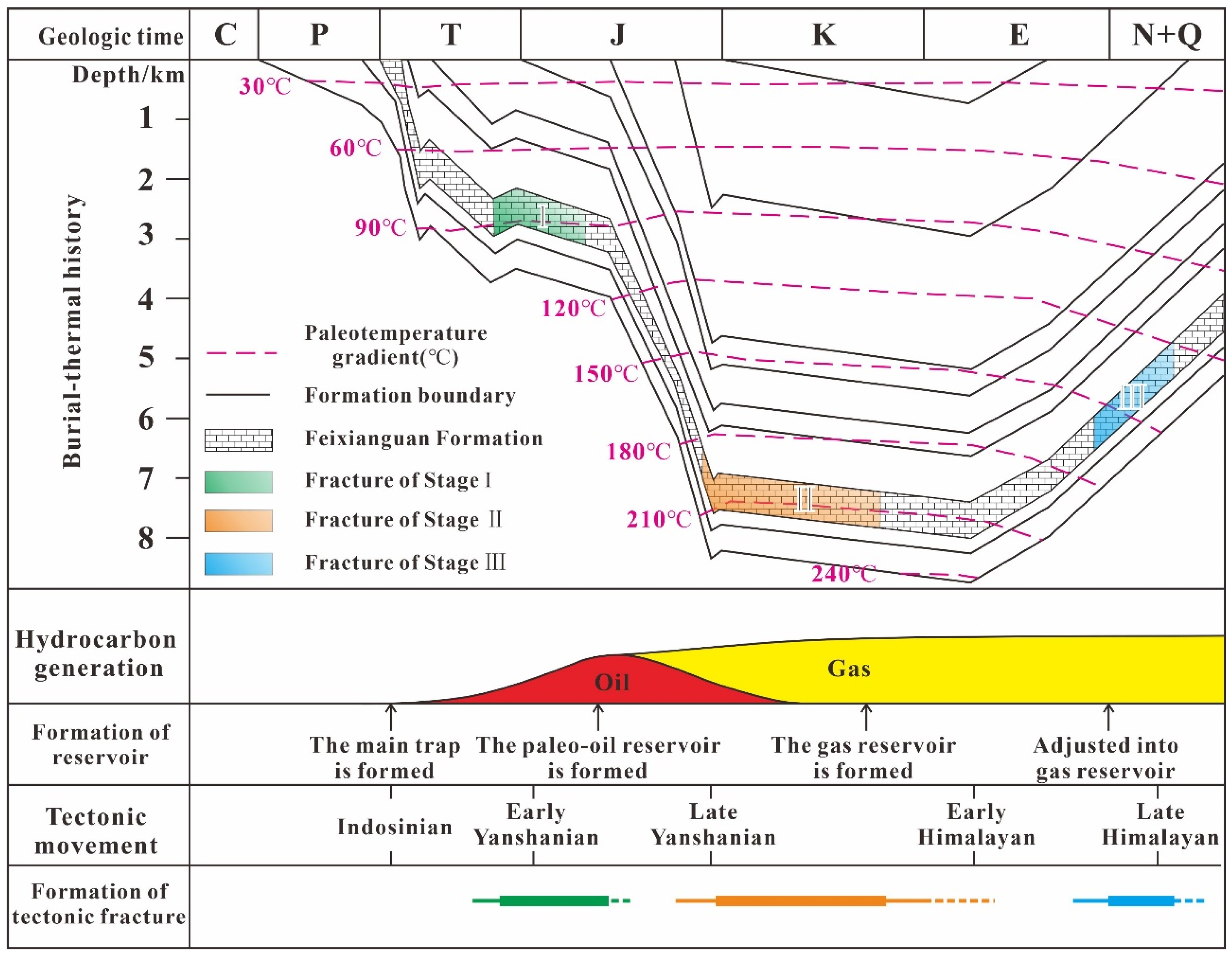
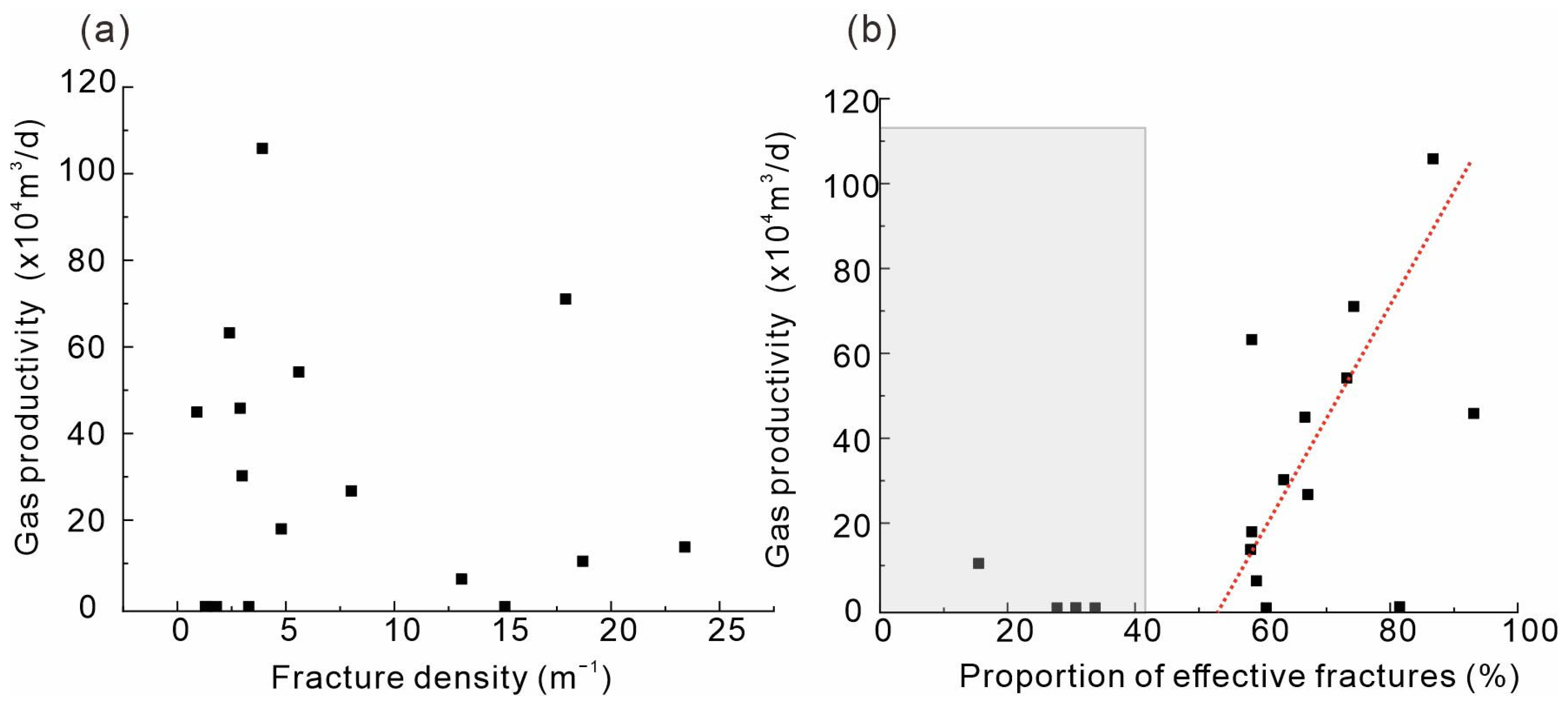
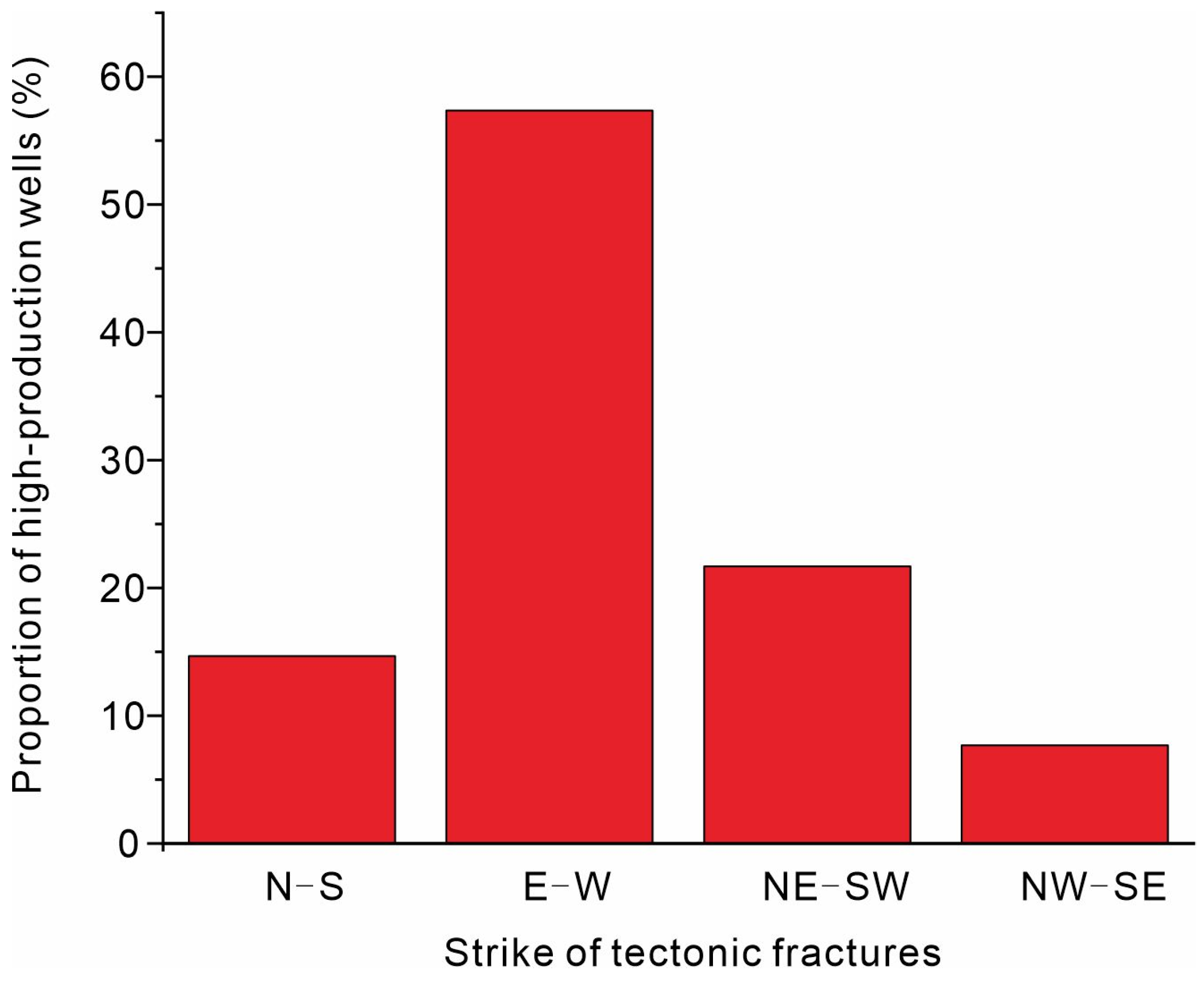
Disclaimer/Publisher’s Note: The statements, opinions and data contained in all publications are solely those of the individual author(s) and contributor(s) and not of MDPI and/or the editor(s). MDPI and/or the editor(s) disclaim responsibility for any injury to people or property resulting from any ideas, methods, instructions or products referred to in the content. |
© 2023 by the authors. Licensee MDPI, Basel, Switzerland. This article is an open access article distributed under the terms and conditions of the Creative Commons Attribution (CC BY) license (https://creativecommons.org/licenses/by/4.0/).
Share and Cite
Guan, C.; Zeng, L.; Yao, Y.; Zhang, H.; Zhang, J.; Liang, D. Natural Fractures and Their Contribution to Natural Gas Migration and Accumulation in Marine Carbonate Reservoirs: Lower Triassic Feixianguan Formation, Northeast Sichuan Basin, China. Sustainability 2023, 15, 16155. https://doi.org/10.3390/su152316155
Guan C, Zeng L, Yao Y, Zhang H, Zhang J, Liang D. Natural Fractures and Their Contribution to Natural Gas Migration and Accumulation in Marine Carbonate Reservoirs: Lower Triassic Feixianguan Formation, Northeast Sichuan Basin, China. Sustainability. 2023; 15(23):16155. https://doi.org/10.3390/su152316155
Chicago/Turabian StyleGuan, Cong, Lianbo Zeng, Yingtao Yao, Hang Zhang, Jiewei Zhang, and Dong Liang. 2023. "Natural Fractures and Their Contribution to Natural Gas Migration and Accumulation in Marine Carbonate Reservoirs: Lower Triassic Feixianguan Formation, Northeast Sichuan Basin, China" Sustainability 15, no. 23: 16155. https://doi.org/10.3390/su152316155
APA StyleGuan, C., Zeng, L., Yao, Y., Zhang, H., Zhang, J., & Liang, D. (2023). Natural Fractures and Their Contribution to Natural Gas Migration and Accumulation in Marine Carbonate Reservoirs: Lower Triassic Feixianguan Formation, Northeast Sichuan Basin, China. Sustainability, 15(23), 16155. https://doi.org/10.3390/su152316155




